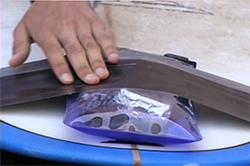News Release
Physics of Surfing Class Introduces Students to Research
San Diego, CA, June 16, 2008 -- It was a sunny Saturday morning in La Jolla and a UCSD student was getting ready to wade in the waves with his surfboard. But the undergraduate wasn’t there to just have fun. He also was trying to measure the physical forces at work when he surfed. Two devices were snugly duct-taped to the front and the back of his board.
The experiment was part of a class titled “The Physics of Surfing” co-taught by Professor David Sandwell at UCSD’s Scripps Institution of Oceanography and Professor Stefan Llewellyn Smith at the Jacobs School of Engineering's Department of Mechanical and Aerospace Engineering. The course is part of the university’s freshman seminars program, which allows students to explore interesting topics and introduces them to research.
Sandwell’s class blends coursework in physics with hands-on experiments. Students learn about how waves form and how they travel through the world’s oceans. They learn that surfboards follow the laws of fluid mechanics. Then they get to go to the beach and see how physics works in the real world.
“It’s sort of like an introduction oceanography-earth sciences class,” Sandwell said about his course.
 |
|
Professors David Sandwell (left) and Stefan Llewellyn Smith co-teach the class.
|
The class is popular, Sandwell said. “There’s always a waiting list,” he added. Sandwell also said he got the idea for the course after one of his colleagues started teaching a class about the physics of sports. A dedicated surfer, Sandwell stashes his board in his office and uses it three or four times a week. He surfs with his teenage children on weekends. The class is like a hobby for him, he said.
“I can do all these experiments I could never do otherwise,” explained the professor, whose research usually focuses on mapping large topographic features beneath the ocean.
For students, Physics of Surfing often turns out to be an introduction to research. “I think what they get out of it is that they learn how to do a lab and collect real data,” Sandwell said.
At the beach
On a sunny May morning, Sandwell’s students gathered at the foot of the Scripps Pier to do just that. Their goal was to measure how fast a surfer paddles on a long board and a short board. They watched as Sandwell and his teaching assistant, Karthik Balakrishnan, wrapped a GPS device and a device that measures speed, called an accelerometer, in aluminum foil. The devices then went into waterproof pouches and were carefully duct-tapped onto a short board. A lucky volunteer got to ride the board into the waves.
 |
|
Sandwell instructs students during the class' first session on the Scripps Pier.
|
In the classroom
Later in the quarter, students went to the beach again to collect more. Sandwell then uploaded the data to the class’ Web site, so undergraduates could work on it either in his lab or on their own computers. Students also shot some video of the experiments, which they later used to make presentations in class.
Sophomore Mac Delaney, a devoted surfer, said the class completely changed the way he thinks about surfing. “Now, when I’m waiting for a wave, I think about all the stuff we learned,” he said. “It’s all I think about.”
The physics explained in class can be pretty complicated, said sophomore John Gomez, who also surfs. But the class is worth it, he added. “They’re putting numbers to what we’re experiencing out there,” Gomez explained.
Back in the classroom, Delaney, Gomez and fellow students listened to Sandwell as he talked about the physical laws that lead to the creation of waves and to Smith, as he explained that surfboards are subject to the laws of fluid mechanics.
A visit from Walter Munk
 |
|
Renowned oceanographer Walter Munk spoke to students and answered their questions.
|
During Munk’s visit, however, shades obscured the view, as the oceanographer commented on a slide show illustrating his life as a researcher and some of his findings. He reminisced about traveling to American Samoa in search of data. “I thought it would be great fun,” he said of the trips.
Munk also took students back to the very beginning of his career, when he served at the Pentagon during WWII. He was 25 years old at the time and suggested that the military should learn to predict waves to perfect beach landings. Munk wasn’t getting any traction, so he enlisted the help of polar explorer and Scripps director Harald Sverdrup, whom he had met in 1939, as a junior at Caltech during a summer stint in La Jolla. Finally, Munk was allowed to conduct his study.
 |
|
A student straps on a device measuring speed onto a longboard.
|
“I believe we were able to save thousands of lives,” Munk said.
After Munk’s talk, Sandwell confided that he and some of his students plan to continue working this summer. They would like to prove that there is such as thing as sets of waves. “We’ll never get funded to do this,” the professor joked.
This story was originally published in This Week @ UCSD, http://thisweek.ucsd.edu.
Media Contacts
Ioana Patringenaru
Jacobs School of Engineering
858-822-0899
ipatrin@ucsd.edu